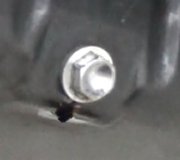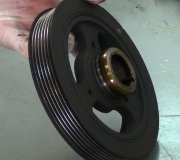Hi guys; excuse me for butting in but here's another suggestion for getting the Easy-Out out. This is a partial copy / paste reply to a similar problem. It's related to a broken thermostat housing bolt but the procedure is the same:
I had a broken bolt exactly like yours on my '88 Grand Caravan a few years ago. It created the perfect "teachable moment" for my students and especially the kid who felt bad for breaking it. You'll need a wire feed welder and an acetylene torch. Propane torch won't work. The flame is too large and not hot enough. Grab a nut with a center hole slightly larger than the bolt diameter. Center the nut over the broken bolt. Use a small torch tip with a nice blue flame with a sharp point. The tip of the flame is the hottest part of the flame. Touch that tip to the center of the bolt to warm it up. The goal is to get the bolt red hot but it never will get that hot because the heat is being sucked away by the intake manifold. Nevertheless, heat the bolt for at least a couple of minutes. Stay away from the nut as much as possible. You want it to stay cool. If you're careful and quick, you can heat the bolt first, then set the nut in place with a pliers just when you're ready to weld. When the bolt is as hot as it's going to get, hand the torch off to a helper and immediately grab the welder. Feed the wire onto the end of the bolt and start to build it up. Stay away from the nut as long as possible. Don't stop welding because you don't want the bolt to have a chance to cool down. As the weld builds, it will fill the hole in the nut and eventually you will also be welding TO the nut. The nut will turn orange. That's ok, but stop welding before the sides of the nut start to melt. You need those sides to be in good shape so a socket will fit on the nut.
Welding works, not by "sticking" to the metal, but by melting the surfaces of the two pieces of metal with a filler metal in between. That's called "penetration". If you don't preheat the bolt, the heat from the welder will be sucked away before the metal of the bolt melts. You'll end up building up the weld until it melts to the nut but it won't have penetrated the bolt. That would be like putting glue on the piece of wood you're using to build a bird house, then assembling the pieces after the glue dries. The preheating gets the bolt up to its melting temperature sooner. It has to reach that temperature from welding before the weld builds up to the nut.
Once the nut is welded to the bolt, let it cool by itself for, ... Oh, ... About ten seconds, then dribble a little water on the nut. Don't pour so much that it floods the surrounding area. You want to shrink the bolt but leave the intake manifold hot. The shock from the water will help break the bond between the bolt and intake manifold. Use a six point socket, ratchet, and extension on the nut to turn the bolt out. If the weld didn't stick to the bolt and you twist the nut off, just grab another nut and try again. I've already had to resort to as many as six attempts before this worked. Sometimes this works better with two people, one to run the torch and one to be standing ready with the welder. Use a high setting on the welder to insure good penetration into the bolt before the weld builds up to the nut.
Okay, I'm back. The problem with the Easy-Out is it's tapered and you're screwing it into soft brass. That will expand it and make it tighter. There is a different type of broken bolt removal tool that might give you better luck. It is a straight shaft with fat grooves. You pound it through the brass fitting to create matching grooves. At that point there's little outward pressure on the brass and turning it doesn't create much more pressure. There's a matching collar you slide onto the shaft to turn with a wrench.
As a last resort you can drill the brass fitting out once the Easy-Out is removed, then install a "Heli-Coil". If you aren't familiar with those I can post the other two thirds of my canned reply.
Wednesday, October 3rd, 2012 AT 7:03 PM




